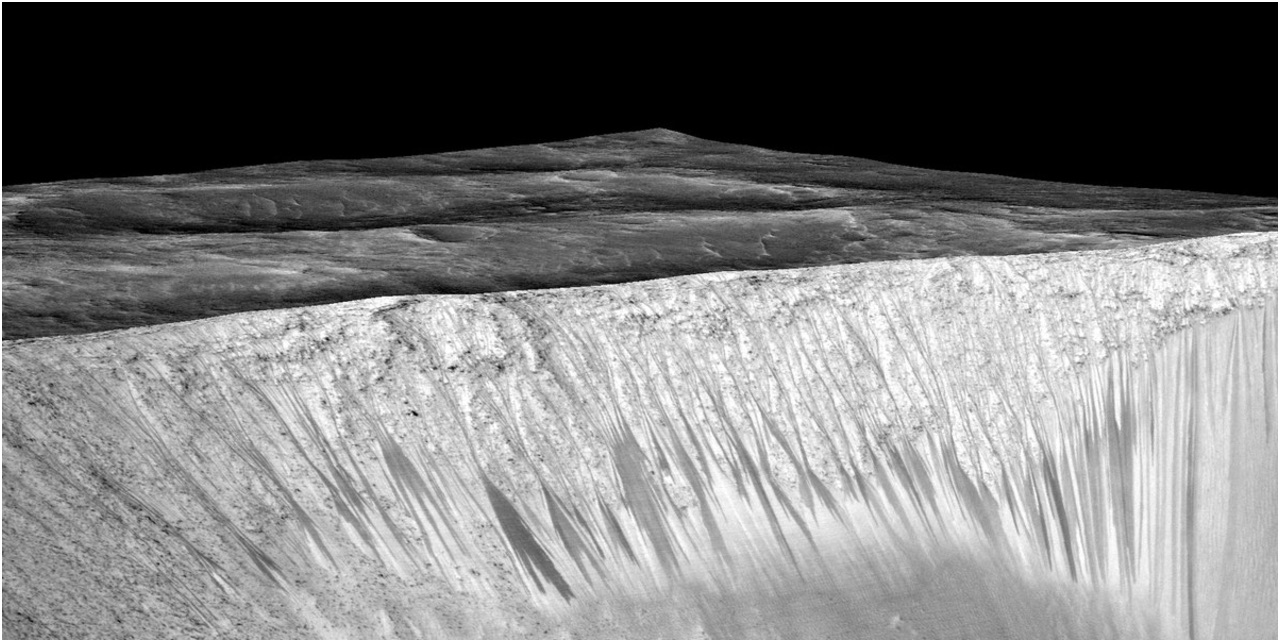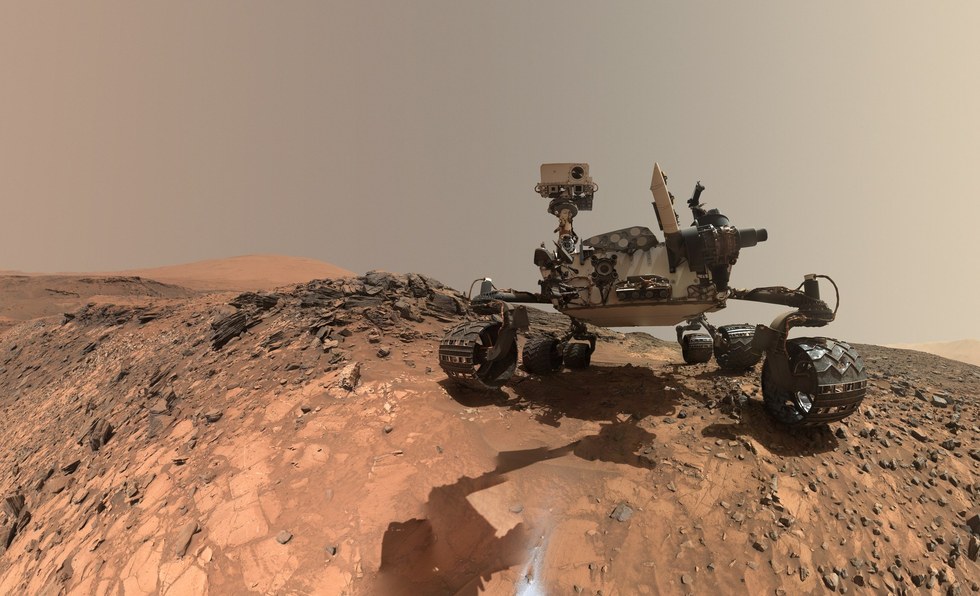Mars Life Could Lurk Within These Salty Streaks

Life as we know it requires liquid water. So you can imagine the excitement when, in 2015, hydrated minerals — or compounds that form in the presence of water — were seen on the same Martian slopes as mysterious features known as "recurring slope lineae" or, simply, RSL.
First imaged in high resolution by NASA's Mars Reconnaissance Orbiter (MRO) in 2006, these features tend to appear and disappear over several months, appearing at times when the sun shines most strongly upon those slopes. Now, the theory is that these RSL could be seasonal flows of water flowing down the slopes. On Earth, where there's water, there's life — could this hold true for the Red Planet?
The challenge for life on Mars is that this water is extremely salty, with a far higher salt concentration than the limit known for Earth microbes. But they are still regions of interest for possible life, and a potential source of water for future Mars exploration.
A new paper published in the journal Astrobiology argues that we should make studying these features a priority.
RELATED: So Liquid Water Flows on Mars — Now What?
"The discovery of a large deposit produced by brines on Mars could hold the key to further human exploration or even colonization of the Red Planet," wrote Javier Martin-Torres and Maria-Paz Zorzano, both members of Lulea University of Technology's division of space technology. "The question then is, are we ready for the next exploration impulse? And from a political and operational point of view it must be asked, in what ways would the discovery of brines on Mars help steer our exploration efforts? In what ways would it hinder our control over Mars contamination? And if we were to colonize Mars, can we do so without further contaminating the planet?"
These questions of interest because of the risk of contaminating Mars with Earth microbes. As careful as we are at sterilizing a Mars rovers, it seems there's always a few hardy microbes left behind.
Breaking space news, the latest updates on rocket launches, skywatching events and more!
NASA and other agencies have guidelines for planetary protection during missions, especially for "special regions" that could have an increased probability of life. So until we get close to these places, the new paper argues, it is best to figure out how to best decrease the risk of us contaminating it. And of course, we must also consider how to stop Martian microbes (if they exist) from contaminating any sample return mission in the future that would bring parts of Mars back to Earth.
Not everyone agrees that RSLs could host life, however.
Richard Zurek is chief scientist both for the MRO and for NASA's Mars exploration program. He cautioned that the amount of water in RSLs is likely more of a "seep" than a stream of water. Furthermore, microbes would have to contend with a very cold, very salty, low-pressure environment if they were to survive in these brines. It's a combination that is difficult for Earth microbes to survive, so he is skeptical microbes could be in these regions on Mars.
"The measurements [from MRO] are measured over 100 meters, a football field, and you can't tell some times if there are hot spots or cold spots somewhere," he told Seeker, adding that the individual features are often only a couple of meters across.
For that region, MRO tends to target areas that have lots of RSLs. Another limitation is different instruments on MRO have different resolutions, making it difficult to compare data across the various observations. "It is hard to get an adequate measurement of the temperature," he said.
Scientists are also still trying to figure out where the briny water originates. MRO can only sample the temperature of the first few centimeters of the regolith, or Mars "soil." Scientists also aren't sure how much water is needed to produce an RSL.
RELATED: Mystery Solved: Water DOES Flow on Mars
Complicating that, MRO is peering through an atmosphere that could make it difficult to see the true contrast on the slopes, so it's not clear how much darker the RSL is than the surrounding terrain. Ongoing calibrations of MRO observations are happening as scientists learn more.
There are some slope streaks on Mars that may or may not be related to RSLs, including some spotted from Gale Crater — the landing site of NASA's Curiosity rover. It is known that there are dark streaks within the long-range view of Curiosity's cameras, but whether these are RSLs are unknown at this point. Then the next question is whether Curiosity should take time from its other work to image these streaks from a distance, Zurek said. Right now, Curiosity is probing different layers of Mount Sharp (Aeolis Mons) for signs of ancient habitable environments.
"The argument is, should we make an exception and drive the rover deliberately to one of these [dark-streak] sites to get a better view, and trade between its ongoing investigations to get to the layers where there are definitely minerals that have been altered in water?" Zurek asked, pointing out the rover could be detouring to image "something that may be no more than a dry debris flow."
It certainly leaves plenty of work available for the High-Resolution Imaging Science Experiment (HiRISE) camera on the MRO, both of which are in excellent health despite spending more than a decade at Mars.
Another new paper in the journal Icarus identifies 239 candidate and confirmed RSL sites within Valles Marineris alone, which is a large canyon that stretches across the equivalent distance of the United States. The valley hosts half of all globally known RSL locations, and given its vast size there are always at least some RSL growing within, "regardless of the season", the paper abstract reads.
"If RSL are caused by water, such a long active season at hundreds of [Valles Marineris] RSL sites suggests that an appreciable source of water must be recharging these RSL," says the paper, which is led by David Stillman at the Southwest Research Institute. The research team adds that modelling indicates a melting temperature of at least -16 degrees Fahrenheit would be needed to make the briny water flow.
"The mechanism(s) by which RSL are recharged annually remain uncertain. Overall, gaining a better understanding of how RSL form and recur can benefit the search for extant life on Mars and could provide details about an in situ water resource," the paper adds.
RELATED: Weird Mars Streaks Could be Liquid Water Stains
Zurek said his team knows there is still a lot to learn about the water activity, especially how RSLs could form in a Martian environment (low pressure, very cold) as opposed to Earth. There are laboratory studies going on to try to get the temperature cycle exactly right; it's hard to replicate because the soil composition is difficult to forecast beyond the salt concentration, he said.
"We are arguing for more work there. Also, we should map out where we think these features might be," he added. While HiRISE has been imaging Mars for more than a decade, it has only mapped out 3 percent of the planet in high resolution. One of the spots it's keeping an eye on now is Gale Crater to see if those streaks are RSLs, which should become clear within the next Martian year (the equivalent of two years).
Zurek added there still is time for MRO to collect much more data, as the orbiter is forecast to work at Mars until at least 2023. This would allow MRO to also act as a communications relay for the Mars 2020 rover, which is expected to land somewhere on Mars in 2021.
WATCH VIDEO: Why Can't We Livestream From Mars?
Originally published on Seeker.

Elizabeth Howell (she/her), Ph.D., was a staff writer in the spaceflight channel between 2022 and 2024 specializing in Canadian space news. She was contributing writer for Space.com for 10 years from 2012 to 2024. Elizabeth's reporting includes multiple exclusives with the White House, leading world coverage about a lost-and-found space tomato on the International Space Station, witnessing five human spaceflight launches on two continents, flying parabolic, working inside a spacesuit, and participating in a simulated Mars mission. Her latest book, "Why Am I Taller?" (ECW Press, 2022) is co-written with astronaut Dave Williams.


